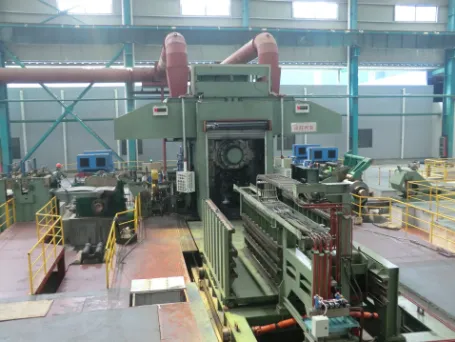
Residual Stress Control and Elimination Methods in Reversible Cold Rolling Process
The reversing cold rolling mill is a critical piece of equipment in the production of high-precision metal strips, particularly for applications requiring tight thickness tolerances and superior surface finishes. Unlike a tandem cold mill, which uses multiple stands in sequence, a reversible rolling mill processes the strip back and forth through a single stand, allowing for greater flexibility in thickness reduction. However, this process introduces significant residual stresses—internal stresses that remain in the material after rolling—which can lead to shape defects such as edge waves, center buckles, and coil set.

Residual Stress Formation in a Reversing Cold Mill
Mechanisms of Residual Stress Development
In a cold reversing mill, residual stresses arise primarily due to non-uniform plastic deformation across the strip width and thickness. Several factors contribute to this phenomenon:
Differential Roll Deflection:
The work rolls in a reversing rolling mill experience bending under high rolling forces, leading to uneven compression across the strip. The center of the strip typically undergoes greater deformation than the edges, creating longitudinal residual stresses.
Friction and Lateral Flow:
Friction between the rolls and the strip causes shear stresses, particularly at the edges, where material tends to flow outward. This results in non-uniform strain distribution, contributing to residual stress buildup.
Thermal Gradients:
Although cold rolling is performed at ambient temperatures, localized heating due to deformation and friction can induce thermal stresses, which may become locked into the material upon cooling.
Work Hardening Effects:
The repeated passes in a reversible cold rolling mill cause cumulative strain hardening, increasing the material’s yield strength but also introducing internal stress imbalances.
Consequences of Uncontrolled Residual Stresses
If not properly managed, residual stresses can lead to:
Shape defects (e.g., warping, camber, and coil set) that complicate downstream processing.
Reduced fatigue life in critical components, particularly in automotive and aerospace applications.
Dimensional instability during machining or heat treatment, where stress relaxation causes distortion.
Residual Stress Control in a Reversible Cold Rolling Mill
To mitigate residual stresses, modern reversing cold mills employ several key strategies:
1. Optimized Rolling Schedule Design
A well-designed rolling schedule in a cold reversing mill ensures balanced reduction per pass, minimizing abrupt strain gradients. Techniques include:
Progressive thickness reduction to avoid excessive work hardening in early passes.
Symmetrical rolling sequences where forward and reverse passes apply uniform deformation.
Intermediate annealing (for certain materials) to relieve stresses between rolling stages.
2. Advanced Roll Crown and Profile Control
Since roll deflection is a major contributor to residual stress, modern reversible rolling mills use:
CVC (Continuously Variable Crown) rolls, which adjust their profile dynamically to maintain uniform pressure distribution.
Work roll bending systems that apply counter-bending forces to compensate for deflection.
Roll cooling optimization to minimize thermal crown variations during rolling.
3. Tension Control Strategies
Proper strip tension in a reversing cold rolling process helps stabilize the material and reduce stress non-uniformity. Key approaches include:
Closed-loop tension control systems that adjust in real time based on strip feedback.
Differential tension profiles across the strip width to counteract edge stresses.
4. Post-Rolling Stress Relief Methods
Even with optimized rolling parameters, some residual stresses remain. Common elimination techniques include:
Skin-pass rolling (temper rolling): A light final pass to homogenize surface stresses.
Thermal stress relief: Low-temperature annealing to relax internal stresses without altering microstructure.
Vibratory stress relief (VSR): An emerging technique where controlled vibrations accelerate stress redistribution.
Reversing Cold Rolling Emerging Technologies for Residual Stress Management
1. Machine Learning and Predictive Modeling
AI-driven process optimization is becoming integral to reversible cold rolling mills. By analyzing historical rolling data, machine learning models can predict residual stress patterns and recommend corrective adjustments in real time.
2. In-Line Residual Stress Measurement
Non-destructive techniques such as:
Ultrasonic stress testing (measuring acoustic wave velocity changes).
X-ray diffraction (XRD) for surface stress mapping.
These allow for immediate feedback and process corrections.
3. Hybrid Rolling Approaches
Some modern mills combine reversing cold rolling with inline tension leveling or laser-assisted rolling to actively counteract stress formation during deformation.
Toward Stress-Free Cold Rolled Products
The reversing cold rolling mill remains indispensable for producing high-quality strip metals, but residual stresses pose a persistent challenge. Through optimized rolling schedules, advanced roll control systems, and innovative stress relief techniques, manufacturers can significantly reduce these detrimental effects.
As Industry 4.0 technologies like AI and real-time monitoring become more integrated into reversible rolling mills, the ability to predict and eliminate residual stresses will continue to improve. This progress ensures that cold-rolled products—especially those used in precision industries like automotive and aerospace—meet ever-stricter performance and reliability standards.
By mastering residual stress control, operators of cold reversing mills can achieve not only superior product quality but also enhanced process efficiency and material sustainability.
-
YWLX’s 1450mm Six-Hi Reversing Mill Goes Live in BangladeshNewsNov.24,2025
-
Adjusting Roll Gap in 6Hi Reversing Cold Rolling Mill for Thin StripNewsNov.13,2025
-
Quality Control Standards for Automatic Gauge Control in Strip RollingNewsNov.13,2025
-
Effect of Skin Pass Rolling on Metal DuctilityNewsNov.13,2025
-
Key Components of a Modern TempermillNewsNov.13,2025
-
Common Wear Patterns of Work Roll in Tandem Cold Mill OperationsNewsNov.13,2025
-
Revolutionary Skin Pass Rolling Technology for Enhanced Steel QualityNewsNov.04,2025










